An Improved Method for Automatic Identification and Assessment of Potential Geohazards Based on MT-InSAR Measurements
Abstract
:1. Introduction
2. The Improved Method
- (1)
- Deformation area recognition: recognize and locate the boundary of each deformation region;
- (2)
- Deformation velocity gradation: classify the deformation velocity magnitude for the points in the deformed regions;
- (3)
- Deformation temporal evolution trend estimation: estimate the temporal evolution trend for the points in the deformed regions;
- (4)
- Deformation instability degree generation: combines the deformation velocity gradation in (2) and trend in (3) to obtain the instability degree for the points in the regions by on the quantitative instability matrix;
- (5)
- Deformation instability refinement: refines the deformation boundary of instability degree in (4).
2.1. Deformation Area Recognition
- (1)
- Data preprocessing: A noise removal method is used to remove the points that are sparsely distributed or significantly different from the neighboring points in displacement [37] to obtain spatially consistent deformation results.
- (2)
- Cluster analysis on deformation point attributes: Set a deformation velocity threshold and the expansion radius parameters. If the point has a deformation velocity larger than the threshold, it is defined as an active point, otherwise it is a stable point. The active points are buffered according to the expansion radius, and attribute clustering is performed following the principle of spatial proximity relationship [29]. Up to this step, the deformation regions formed by clustering of active points can be obtained (Figure 2b). In order to refine the boundary shape, a smoothing process is performed to the expansion area.
- Velocity threshold: Standard deviation, , calculated by the deformation velocity values from MT-InSAR. It reflects the sensitivity and noise level of the results. It is used to reclassify the points by activity [25,28]. In this study, the value of 3σ is adopted to determine the active point and stable point.
- Buffer distance: Deformation points within the buffer distance are considered belonging to the same deformation area. The buffer distance can be adjusted according to the spatial resolution of the MT-InSAR result and geological conditions of the study area. In this study, we set the buffer distance as 30 m.
- (3)
- Preliminary identification of the deformation regions: Identify multiple deformed regions according to the cluster analysis result in step (2). Some deformation regions may be noise or error. Therefore, we eliminate the deformation regions smaller than the given minimum size to improve the distribution of the results.
- Minimum size: set the minimum area of deformation regions (km2) set according to the local geological background and remove regions smaller than the threshold, as they may be caused by data processing errors, atmospheric effects, and so on. In this study, we set the minimum area as 0.05 km2 and 0.1 km2 for mountainous and urban areas, respectively.
- (4)
- Deformation result refinement: Using the preliminary results obtained in step (3) and the Delaunay triangulation algorithm [38] to connect all the boundary points of a single area to generate the boundary of the smallest convex polygon. Then, generate the boundary of each deformation region, considering the topology relationship of boundaries.
2.2. Deformation Velocity Gradation
2.3. Deformation Temporal Evolution Trend Estimation
2.4. Deformation Instability Degree Generation
2.5. Deformation Instability Refinement
3. Experiment and Data Processing
3.1. Study Area and Datasets
3.2. MT-InSAR Data Processing
3.3. Decomposition of the Slope Deformation
4. Results and Analysis
4.1. Deformation Extraction Results of Lajia Town
4.2. Deformation Extraction Results of Dongguan City
5. Discussion
6. Conclusions
Author Contributions
Funding
Institutional Review Board Statement
Informed Consent Statement
Data Availability Statement
Acknowledgments
Conflicts of Interest
Abbreviations
| MT-InSAR | Multi-temporal Interferometric Synthetic Aperture Radar |
| InSAR | Interferometric Synthetic Aperture Radar |
| SBAS-InSAR | Small Baseline Subsets Interferometric Synthetic Aperture Radar |
| SAR | Synthetic Aperture Radar |
| PS-InSAR | Persistent Scatterer Interferometric Synthetic Aperture Radar |
| DInSAR | Differential Synthetic Aperture Radar Interferometry |
| ADA | Active deformation areas |
| GIS | Geographic Information System |
| EAM | Exponential acceleration model |
| ULM | Unary linear model |
| EMM | Exponential mitigation model |
| NSC | Deformation points without specific characteristic |
| RMSE | Root-Mean-Square Error |
| R | Correlation Coefficient |
| SRTM | Shuttle Radar Topography Mission |
| DEM | Digital elevation model |
| MCF | Minimum Cost Flow |
| SVD | Singular Value Decomposition |
| 2D | Two dimensional |
| LOS | Line Of Sight |
Appendix A
| Study Areas | Parameters | Acquisition Date | |
|---|---|---|---|
| Lajia Town, Qinghai Province (Mountainous area) | Direction | Descending | 2017/01/18, 2017/02/11, 2017/03/25, 2017/04/06, 2017/04/18, 2017/04/30, 2017/05/12, 2017/06/05, 2017/06/17, 2017/06/29, 2017/07/11, 2017/07/23, 2017/08/04, 2017/08/16, 2017/08/28, 2017/09/09, 2017/09/21, 2017/10/03, 2017/10/15, 2017/10/27, 2017/11/08, 2017/11/20, 2017/12/02, 2017/12/14, 2017/12/26, 2018/01/07, 2018/01/19, 2018/01/31, 2018/02/12, 2018/02/24, 2018/03/08, 2018/03/20, 2018/04/01, 2018/04/13, 2018/04/25, 2018/05/07, 2018/05/19, 2018/05/31, 2018/06/12, 2018/06/24, 2018/07/06, 2018/07/18, 2018/08/11, 2018/08/23, 2018/09/04, 2018/09/16, 2018/09/28,2018/10/10, 2018/10/22, 2018/11/03, 2018/11/15, 2018/11/27, 2018/12/21, 2019/01/02, 2019/01/14, 2019/01/26, 2019/02/07, 2019/02/19, 2019/03/03, 2019/03/15, 2019/03/27, 2019/04/08, 2019/04/20, 2019/05/02, 2019/05/14, 2019/05/26, 2019/06/07, 2019/06/19, 2019/07/01, 2019/07/13 |
| Orbit | T33 | ||
| Heading | −169.73° | ||
| Incidence | 33.69° | ||
| Pixel Spacing (Rg × Az) | 2.33 × 13.96 m | ||
| Number of images | 71 | ||
| Direction | Ascending | 2017/01/24, 2017/02/05, 2017/02/17, 2017/03/25, 2017/04/06, 2017/04/18, 2017/04/30, 2017/05/12, 2017/05/24, 2017/06/05, 2017/06/17, 2017/06/29, 2017/07/11, 2017/07/23, 2017/08/04, 2017/08/16, 2017/08/28, 2017/09/21, 2017/10/03, 2017/10/15, 2017/10/27, 2017/11/08, 2017/11/20, 2017/12/02, 2017/12/14, 2018/12/26, 2018/01/07, 2018/01/19, 2018/01/31, 2018/02/12, 2018/02/24, 2018/03/08, 2018/03/20, 2018/04/01, 2018/04/13, 2018/04/25, 2018/05/07, 2018/05/19, 2018/05/31, 2018/06/12, 2018/06/24, 2018/07/18, 2018/07/30, 2018/08/11, 2018/08/23, 2018/09/04, 2018/09/16, 2018/09/28, 2018/10/10, 2018/10/22, 2018/11/03, 2018/11/15, 2018/11/27, 2018/12/21, 2019/01/02, 2019/01/14, 2019/01/26, 2019/02/07, 2019/02/19, 2019/03/03, 2019/03/15, 2019/03/27, 2019/04/08, 2019/04/20, 2019/05/02, 2019/05/14, 2019/05/26, 2019/06/07, 2019/06/19, 2019/08/18 | |
| Orbit | T26 | ||
| Heading | −10.05° | ||
| Incidence | 33.81° | ||
| Pixel Spacing (Rg × Az) | 2.33 × 13.98 m | ||
| Number of images | 73 | ||
| Dongguan, Guangdong Province (Urban area) | Direction | Ascending | 2018/12/08, 2018/12/20, 2019/01/01, 2019/01/13, 2019/01/25, 2019/02/06, 2019/02/18, 2019/03/02, 2019/03/14, 2019/03/26, 2019/04/07, 2019/04/19, 2019/05/01, 2019/05/13, 2019/06/06, 2019/06/18, 2019/06/30, 2019/07/12, 2019/07/24, 2019/08/05, 2019/08/17, 2019/08/29, 2019/09/10, 2019/09/22, 2019/10/04, 2019/10/16, 2019/10/28, 2019/11/09, 2019/11/21, 2019/12/03, 2019/12/15, 2019/12/27 |
| Orbit | T11 | ||
| Heading | −10.55° | ||
| Incidence | 34.04° | ||
| Pixel Spacing (Rg × Az) | 2.33 × 14.00 m | ||

References
- Zhang, B.; Wang, R.; Deng, Y.; Ma, P.; Lin, H.; Wang, J. Mapping the Yellow River Delta land subsidence with multitemporal SAR interferometry by exploiting both persistent and distributed scatterers. ISPRS J. Photogramm. Remote Sens. 2019, 148, 157–173. [Google Scholar] [CrossRef]
- Costantini, M.; Ferretti, A.; Minati, F.; Falco, S.; Trillo, F.; Colombo, D.; Novali, F.; Malvarosa, F.; Mammone, C.; Vecchioli, F.; et al. Analysis of surface deformations over the whole Italian territory by interferometric processing of ERS, Envisat and COSMO-SkyMed radar data. Remote Sens. Environ. 2017, 202, 250–275. [Google Scholar] [CrossRef]
- Bianchini, S.; Raspini, F.; Solari, L.; Del Soldato, M.; Ciampalini, A.; Rosi, A.; Casagli, N. From Picture to Movie: Twenty Years of Ground Deformation Recording Over Tuscany Region (Italy) with Satellite InSAR. Front. Earth Sci. 2018, 6, 177. [Google Scholar] [CrossRef] [Green Version]
- Ferretti, A.; Prati, C.; Rocca, F. Permanent scatterers in SAR interferometry. IEEE Trans. Geosci. Remote Sens. 2001, 39, 8–20. [Google Scholar] [CrossRef]
- Ferretti, A.; Prati, C.; Rocca, F. Nonlinear subsidence rate estimation using permanent scatterers in differential SAR interferometry. IEEE Trans. Geosci. Remote Sens. 2000, 38, 2202–2212. [Google Scholar] [CrossRef] [Green Version]
- Berardino, P.; Fornaro, G.; Lanari, R.; Sansosti, E. A new algorithm for surface deformation monitoring based on small baseline differential SAR interferograms. IEEE Trans. Geosci. Remote Sens. 2002, 40, 2375–2383. [Google Scholar] [CrossRef] [Green Version]
- Lanari, R.; Mora, O.; Manunta, M.; Mallorqui, J.J.; Berardino, P.; Sansosti, E. A small baseline approach for investigating deformation on full resolution differential SAR interferograms. IEEE Trans. Geosci. Remote Sens. 2004, 42, 1377–1386. [Google Scholar] [CrossRef]
- Ferretti, A.; Fumagalli, A.; Novali, F.; Prati, C.; Rocca, F.; Rucci, A. A new algorithm for processing interferometric data-stacks: SqueeSAR. IEEE Trans. Geosci. Remote Sens. 2011, 99. [Google Scholar] [CrossRef]
- Zhu, J.; Li, Z.; Hu, J. Research Progress and Methods of InSAR for Deformation Monitoring. Acta Geod. Cartogr. Sin. 2017, 46, 1717–1733. [Google Scholar] [CrossRef]
- Mura, J.C.; Paradella, W.R.; Gama, F.F.; Silva, G.G.; Galo, M.; Camargo, P.O.; Silva, A.Q.; Silva, A. Monitoring of non-linear ground movement in an open pit iron mine based on an integration of advanced DInSAR techniques using TerraSAR-X data. Remote Sens. 2016, 8, 409. [Google Scholar] [CrossRef] [Green Version]
- Xu, B.; Feng, G.; Li, Z.; Wang, Q.; Wang, C.; Xie, R. Coastal Subsidence Monitoring Associated with Land Reclamation Using the Point Target Based SBAS-InSAR Method: A Case Study of Shenzhen, China. Remote Sens. 2016, 8, 652. [Google Scholar] [CrossRef] [Green Version]
- Ma, P.; Wang, W.; Zhang, B.; Wang, J.; Shi, G.; Huang, G.; Chen, F.; Jiang, L.; Lin, H. Remotely sensing large-and small-scale ground subsidence: A case study of the Guangdong–Hong Kong–Macao Greater Bay Area of China. Remote Sens. Environ. 2019, 232, 111282. [Google Scholar] [CrossRef]
- Bianchini, S.; Cigna, F.; Righini, G.; Proietti, C.; Casagli, N. Landslide HotSpot Mapping by means of Persistent Scatterer Interferometry. Environ. Earth Sci. 2012, 67, 1155–1172. [Google Scholar] [CrossRef]
- Xiong, Z.; Feng, G.; Feng, Z.; Miao, L.; Wang, Y.; Yang, D.; Luo, S. Pre-and post-failure spatial-temporal deformation pattern of the Baige landslide retrieved from multiple radar and optical satellite images. Eng. Geol. 2020, 279, 105880. [Google Scholar] [CrossRef]
- Xu, W.; Xie, L.; Aoki, Y.; Rivalta, E.; Jónsson, S. Volcano-wide deformation after the 2017 Erta Ale dike intrusion, Ethiopia, observed with radar interferometry. J. Geophys. Res. Solid Earth. 2020, 125, e2020JB019562. [Google Scholar] [CrossRef]
- Feng, G.C.; Li, Z.W.; Xu, B.; Shan, X.J.; Zhang, L.; Zhu, J.J. Coseismic deformation of the 2015 MW 6.4 Pishan, China, earthquake, estimated from Sentinel1 and ALOS2 data. Seismol. Res. Lett. 2016, 87, 800–806. [Google Scholar] [CrossRef]
- He, L.; Feng, G.; Li, Z.; Feng, Z.; Gao, H.; Wu, X. Source parameters and slip distribution of the 2018 Mw 7.5 Palu, Indonesia earthquake estimated from space-based geodesy. Tectonophysics 2019, 772, 228216. [Google Scholar] [CrossRef]
- Tomás, R.; Pagán, J.I.; Navarro, J.A.; Cano, M.; Pastor, J.L.; Riquelme, A.; Cuevas-González, M.; Crosetto, M.; Barra, A.; Monserrat, O.; et al. Semi-automatic identification and pre-screening of geological–geotechnical deformational processes using persistent scatterer interferometry datasets. Remote Sens. 2019, 11, 1675. [Google Scholar] [CrossRef] [Green Version]
- Zhang, Y.; Meng, X.; Chen, G.; Qiao, L.; Zeng, R.; Chang, J. Detection of geohazards in the Bailong River Basin using synthetic aperture radar interferometry. Landslides 2016, 13, 1273–1284. [Google Scholar] [CrossRef]
- Zhang, Y.; Meng, X.; Jordan, C.; Novellino, A.; Dijkstra, T.; Chen, G. Investigating slow-moving landslides in the Zhouqu region of China using InSAR time series. Landslides 2018, 15, 1299–1315. [Google Scholar] [CrossRef]
- Liu, X.; Zhao, C.; Zhang, Q.; Lu, Z.; Li, Z.; Yang, C.; Zhu, W.; Zeng, J.; Chen, L.; Liu, C. Integration of Sentinel-1 and ALOS/PALSAR-2 SAR datasets for mapping active landslides along the Jinsha River corridor, China. Eng. Geol. 2021, 284, 106033. [Google Scholar] [CrossRef]
- Ma, P.; Lin, H. Robust Detection of Single and Double Persistent Scatterers in Urban Built Environments. IEEE Trans. Geosci. Remote Sens 2016, 54, 2124–2139. [Google Scholar] [CrossRef]
- Zhu, M.; Wan, X.; Fei, B.; Qiao, Z.; Ge, C.; Minati, F.; Vecchioli, F.; Li, J.; Costantini, M. Detection of Building and Infrastructure Instabilities by Automatic Spatiotemporal Analysis of Satellite SAR Interferometry Measurements. Remote Sens. 2018, 10, 1816. [Google Scholar] [CrossRef] [Green Version]
- Semple, A.G.; Pritchard, M.E.; Lohman, R.B. An Incomplete Inventory of Suspected Human-Induced Surface Deformation in North America Detected by Satellite Interferometric Synthetic-Aperture Radar. Remote Sens. 2017, 9, 1296. [Google Scholar] [CrossRef] [Green Version]
- Barra, A.; Solari, L.; Béjar-Pizarro, M.; Monserrat, O.; Bianchini, S.; Herrera, G.; Crosetto, M.; Sarro, R.; González-Alonso, E.; Mateos, R.; et al. A Methodology to Detect and Update Active Deformation Areas Based on Sentinel-1 SAR Images. Remote Sens. 2017, 9, 1002. [Google Scholar] [CrossRef] [Green Version]
- Solari, L.; Barra, A.; Herrera, G.; Bianchini, S.; Monserrat, O.; Béjar-Pizarro, M.; Crosetto, M.; Sarro, R.; Moretti, S. Fast detection of ground motions on vulnerable elements using Sentinel-1 InSAR data. Geomat. Nat. Hazards Risk 2018, 9, 152–174. [Google Scholar] [CrossRef] [Green Version]
- Mirmazloumi, S.M.; Barra, A.; Crosetto, M.; Monserrat, O.; Crippa, B. Pyrenees deformation monitoring using Sentinel-1 data and the Persistent Scatterer Interferometry technique. Procedia Comput. Sci. 2021, 181, 671–677. [Google Scholar] [CrossRef]
- Aslan, G.; Foumelis, M.; Raucoules, D.; De Michele, M.; Bernardie, S.; Cakir, Z. Landslide Mapping and Monitoring Using Persistent Scatterer Interferometry (PSI) Technique in the French Alps. Remote Sens. 2020, 12, 1305. [Google Scholar] [CrossRef] [Green Version]
- Solari, L.; Bianchini, S.; Franceschini, R.; Barra, A.; Monserrat, O.; Thuegaz, P.; Bertolo, D.; Crosetto, M.; Catani, F. Satellite interferometric data for landslide intensity evaluation in mountainous regions. Int. J. Appl. Earth Obs. Geoinf. 2020, 87, 102028. [Google Scholar] [CrossRef]
- Béjar-Pizarro, M.; Notti, D.; Mateos, R.M.; Ezquerro, P.; Centolanza, G.; Herrera, G.; Bru, G.; Sanabria, M.; Solari, L.; Duro, J.; et al. Mapping Vulnerable Urban Areas Affected by Slow-Moving Landslides Using Sentinel-1 InSAR Data. Remote Sens. 2017, 9, 876. [Google Scholar] [CrossRef] [Green Version]
- Navarro, J.A.; Tomás, R.; Barra, A.; Pagán, J.I.; Reyes-Carmona, C.; Solari, L.; Crosetto, M. ADAtools: Automatic detection and classification of active deformation areas from PSI displacement maps. ISPRS Int. J. Geo-Inf. 2020, 9, 584. [Google Scholar] [CrossRef]
- Bianchini, S.; Solari, L.; Casagli, N. A GIS-Based Procedure for Landslide Intensity Evaluation and Specific Risk Analysis Supported by Persistent Scatterers Interferometry (PSI). Remote Sens. 2017, 9, 1093. [Google Scholar] [CrossRef] [Green Version]
- Ghorbanzadeh, O.; Blaschke, T.; Aryal, J.; Gholaminia, K. A new GIS-based technique using an adaptive neuro-fuzzy inference system for land subsidence susceptibility mapping. J. Spat. Sci. 2018, 1–17. [Google Scholar] [CrossRef] [Green Version]
- Raspini, F.; Bianchini, S.; Ciampalini, A.; Del Soldato, M.; Solari, L.; Novali, F.; Del Conte, S.; Rucci, A.; Ferretti, A.; Casagli, N. Continuous, semi-automatic monitoring of ground deformation using Sentinel-1 satellites. Sci. Rep. 2018, 8, 7253. [Google Scholar] [CrossRef] [Green Version]
- Raspini, F.; Bianchini, S.; Ciampalini, A.; Del Soldato, M.; Montalti, R.; Solari, L.; Tofani, V.; Casagli, N. Persistent Scatterers continuous streaming for landslide monitoring and mapping: The case of the Tuscany region (Italy). Landslides 2019, 16, 2033–2044. [Google Scholar] [CrossRef] [Green Version]
- Del Soldato, M.; Solari, L.; Raspini, F.; Bianchini, S.; Ciampalini, A.; Montalti, R.; Ferretti, A.; Pellegrineschi, V.; Casagli, N. Monitoring Ground Instabilities Using SAR Satellite Data: A Practical Approach. ISPRS Int. J. Geoinf. 2019, 8, 307. [Google Scholar] [CrossRef] [Green Version]
- Socquet, A.; Hollingsworth, J.; Pathier, E.; Bouchon, M. Evidence of supershear during the 2018 magnitude 7.5 Palu earthquake from space geodesy. Nat. Geosci. 2019, 12, 192–199. [Google Scholar] [CrossRef]
- Lee, D.T.; Schachter, B.J. Two algorithms for constructing a Delaunay triangulation. Int. J. Comput. Inf. Sci. 1980, 9, 219–242. [Google Scholar] [CrossRef]
- Cruden, D.M.; Varnes, D.J. Landslide Types and Processes. In Landslides: Investigation and Mitigation; Special Report 247-Transportation Research Board, National Research Council; Turner, A.K., Schuster, R.L., Eds.; National Academy Press: Washington, DC, USA, 1996; pp. 36–75. [Google Scholar]
- Cigna, F.; Bianchini, S.; Casagli, N. How to assess landslide activity and intensity with Persistent Scatterer Interferometry (PSI): The PSI-based matrix approach. Landslides 2013, 5, 1–17. [Google Scholar] [CrossRef] [Green Version]
- Herrera, G.; Gutiérrez, F.; García-Davalillo, J.C.; Guerrero, J.; Notti, D.; Galve, J.P.; Fernández-Merodo, J.A.; Cooksley, G. Multi-sensor advanced DInSAR monitoring of very slow landslides: The Tena Valley case study (Central Spanish Pyrenees). Remote Sens. Environ. 2013, 120, 31–43. [Google Scholar] [CrossRef]
- Zhang, C.S.; Zhang, Y.C.; Ma, Y.S. Regional dangerous on the deological hazards of collapse, landslide and debris flows in the upper reaches of the yellow river. J. Geomech. 2003, 2, 143–153. [Google Scholar]
- Dong, H.G.; Huang, C.S.; Chen, W.; Zhang, H.X.; Zhi, B.F.; Zhao, X.W. Anylysis of Environmental Geological Control Factors and Problems in the Pearl River Delta. Chin. Geol. 2012, 39, 539–549. [Google Scholar]
- Yi, S.M.; Liang, C.S. Geological Hazard and Prevention in Guangdong Province. Science Press: Beijing, China, 2010. [Google Scholar]
- Notti, D.; Herrera, G.; Bianchini, S.; Meisina, C.; García-Davalillo, J.C.; Zucca, F. A methodology for improving landslide PSI data analysis. Int. J. Remote Sens. 2014, 35, 2186–2214. [Google Scholar] [CrossRef]
- Zhao, C.Y.; Kang, Y.; Zhang, Q.; Zhu, W.; Li, B. Landslide detection and monitoring with InSAR technique over upper reaches of Jinsha River, China. In Proceedings of the IGARSS 2016, Beijing, China, 10–15 July 2016. [Google Scholar] [CrossRef]
- Huffman, G.J.; Stocker, D.T.; Bolvin, E.J.; Nelkin, J.T. GPM IMERG Final Precipitation L3 1 Month 0.1 Degree × 0.1 Degree V06; Goddard Earth Sciences Data and Information Services Center (GES DISC): Greenbelt, MD, USA, 2019. [CrossRef]
- Li, G.; Feng, G.C.; Xiong, Z.Q.; Liu, Q.; Xie, R.A.; Zhu, X.L.; Luo, S.R.; Du, Y. Surface deformation evolution in the Pearl River Delta between 2006 and 2011 derived from the ALOS1/PALSAR images. Earth Planets Space 2020, 72, 1–14. [Google Scholar] [CrossRef]
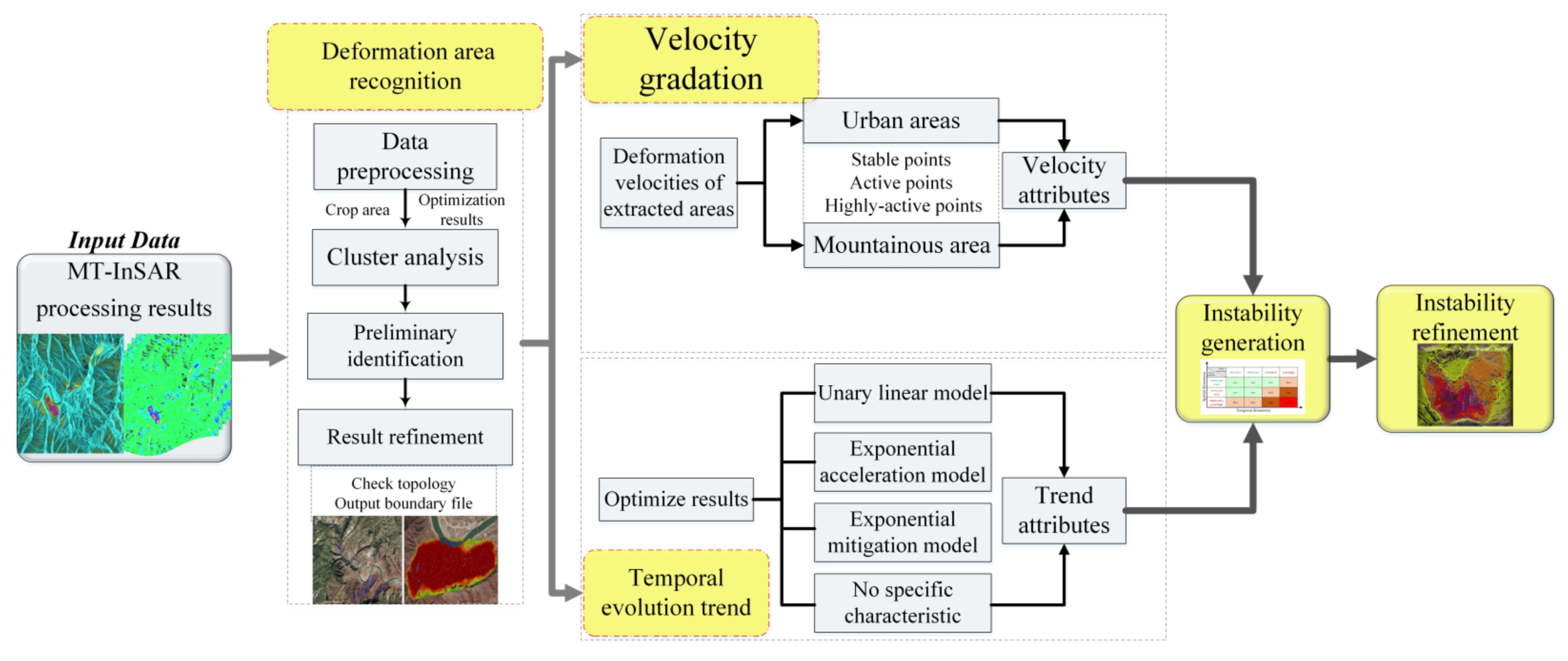
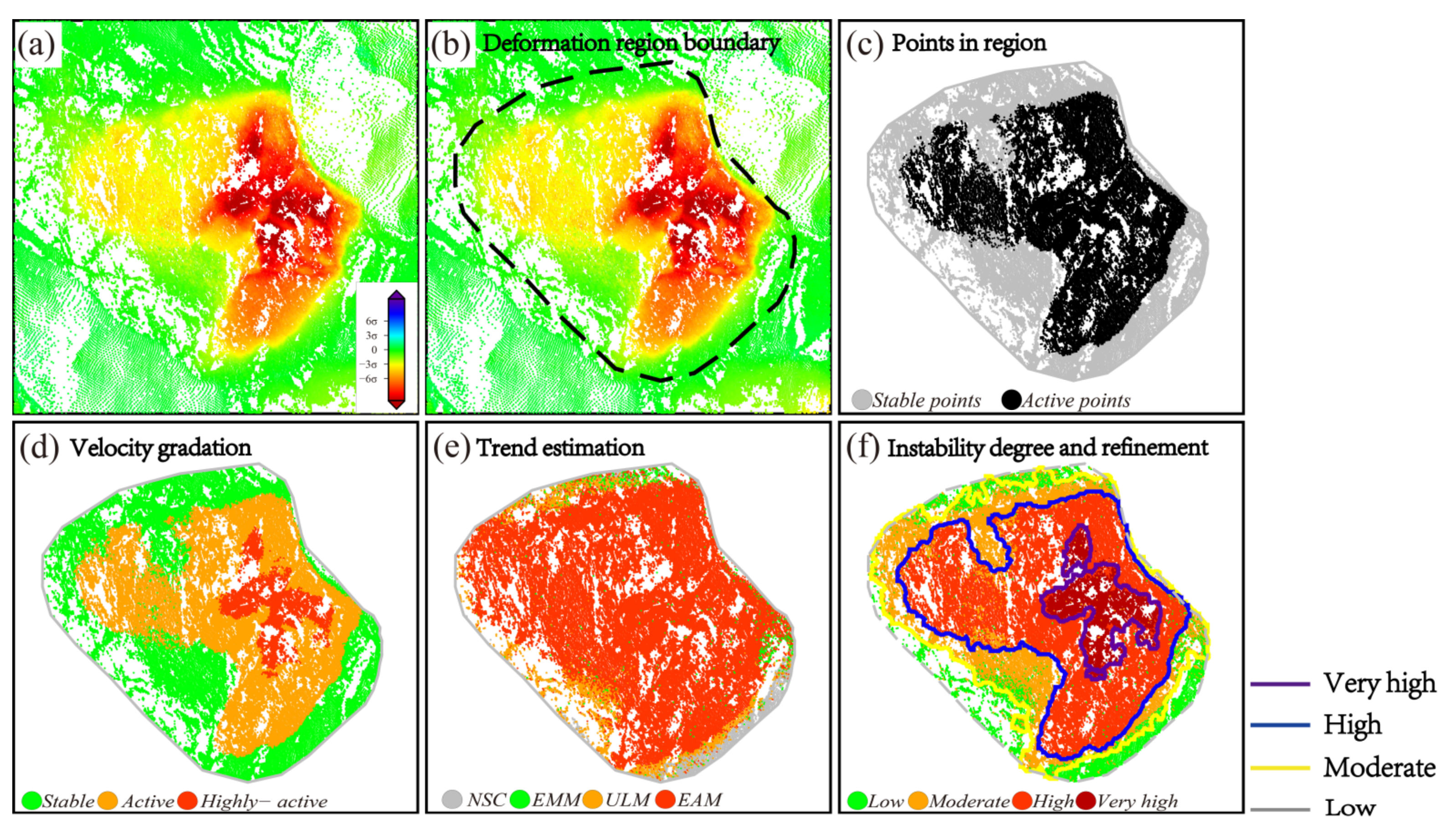
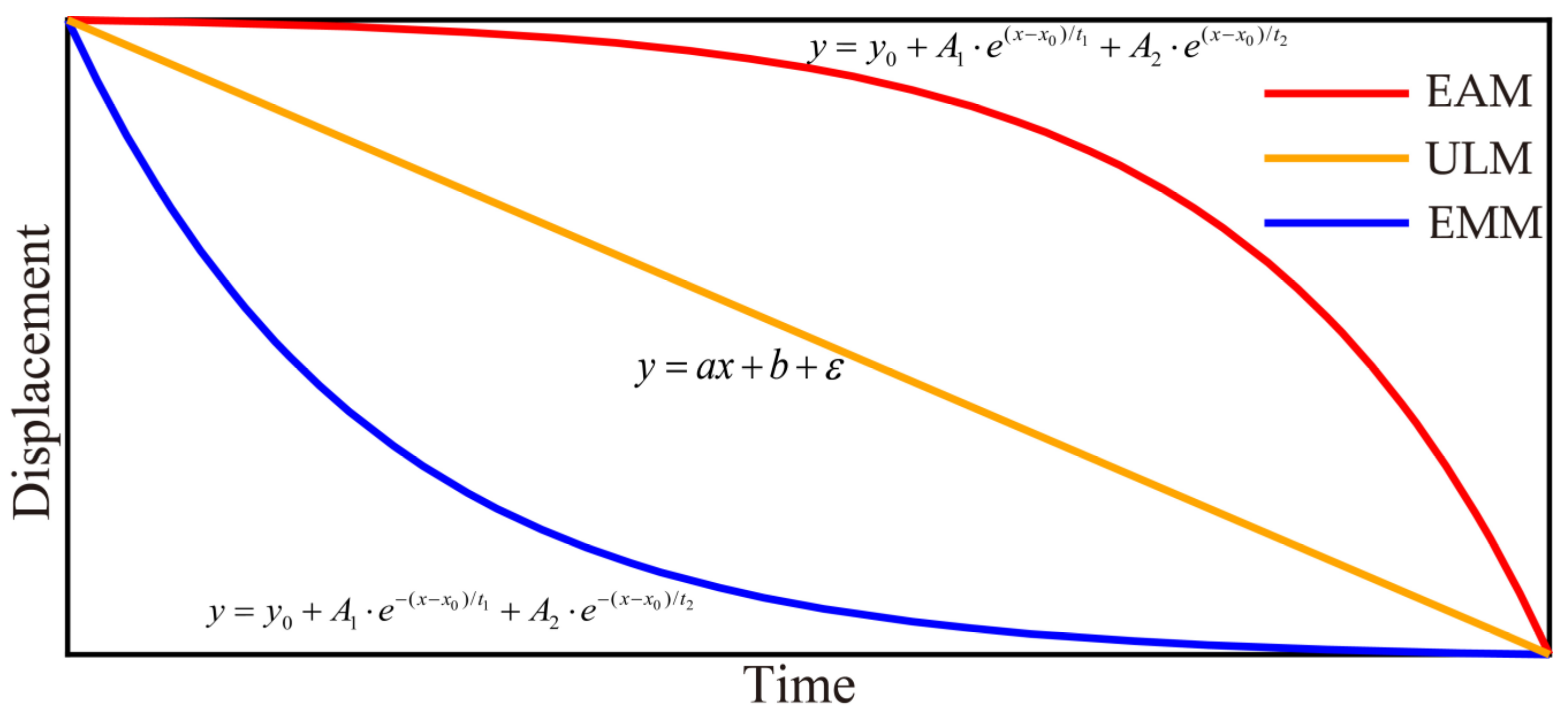
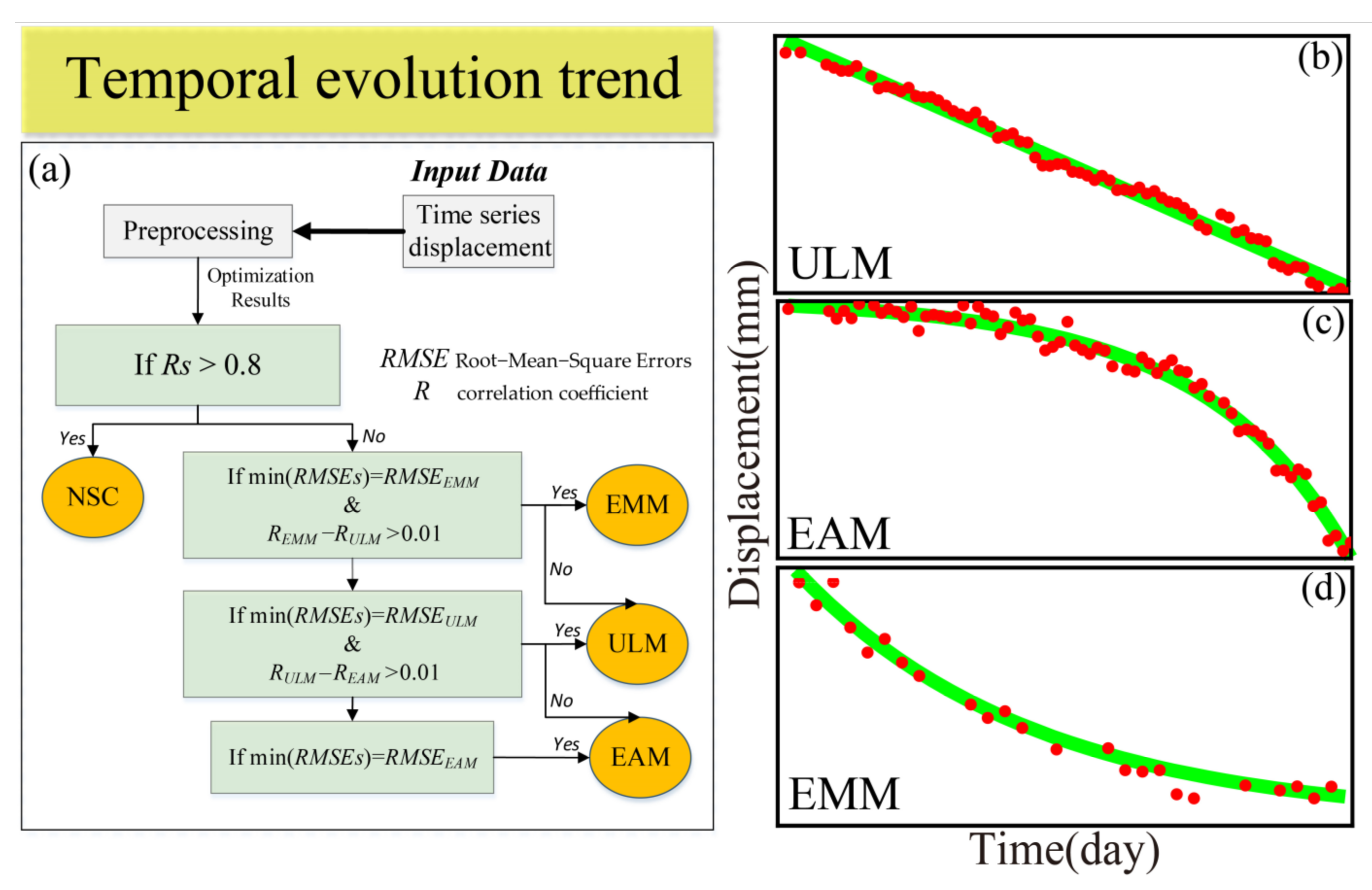

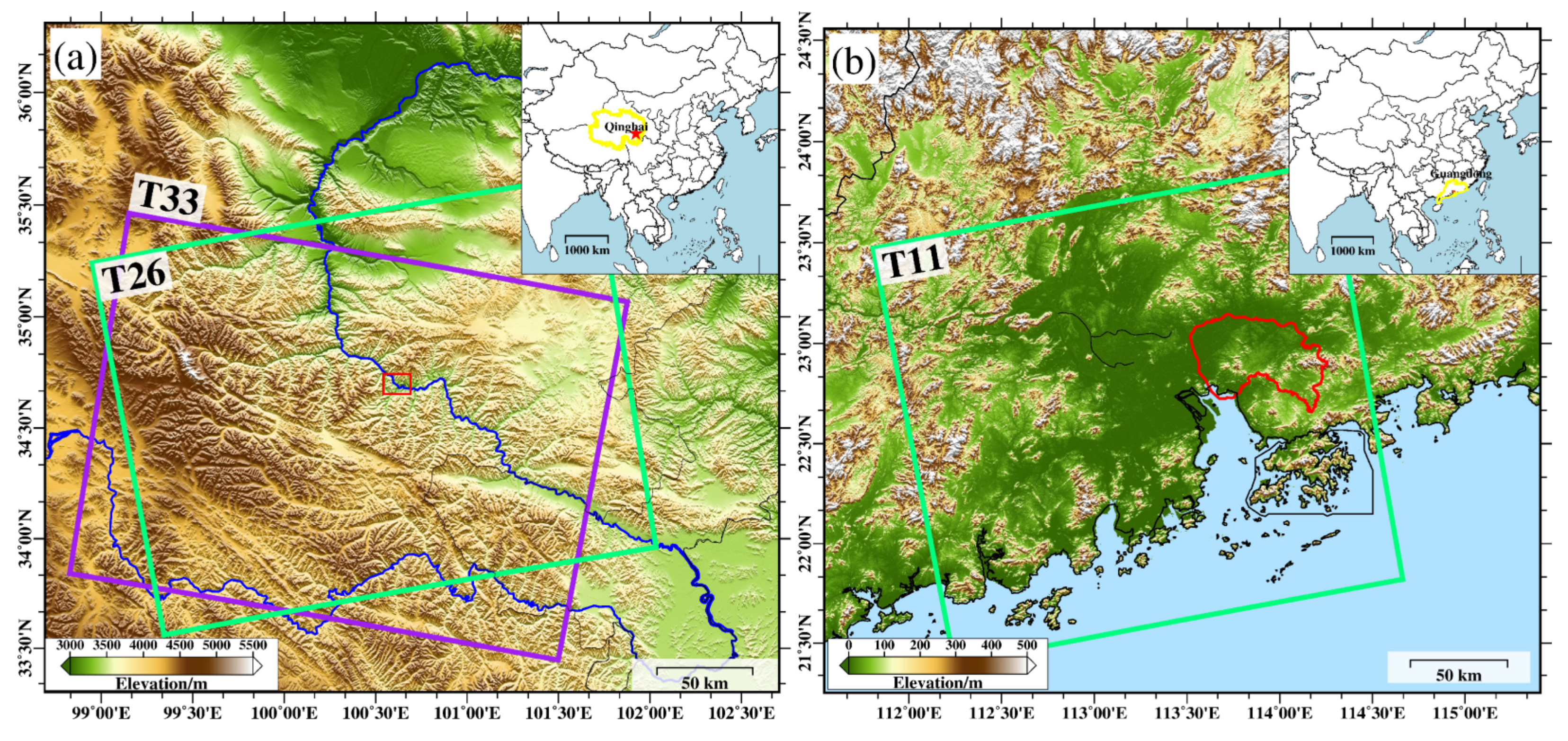

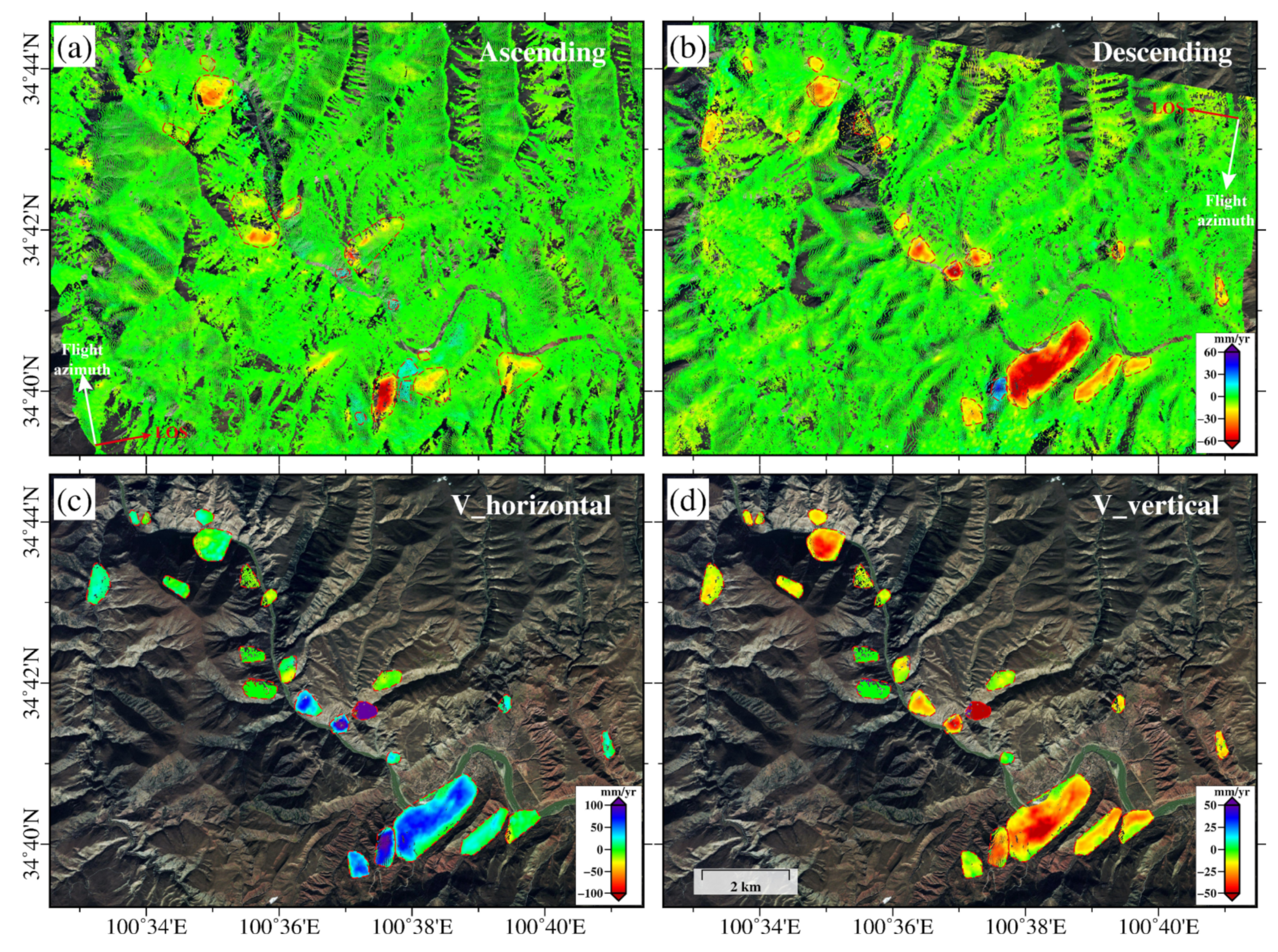


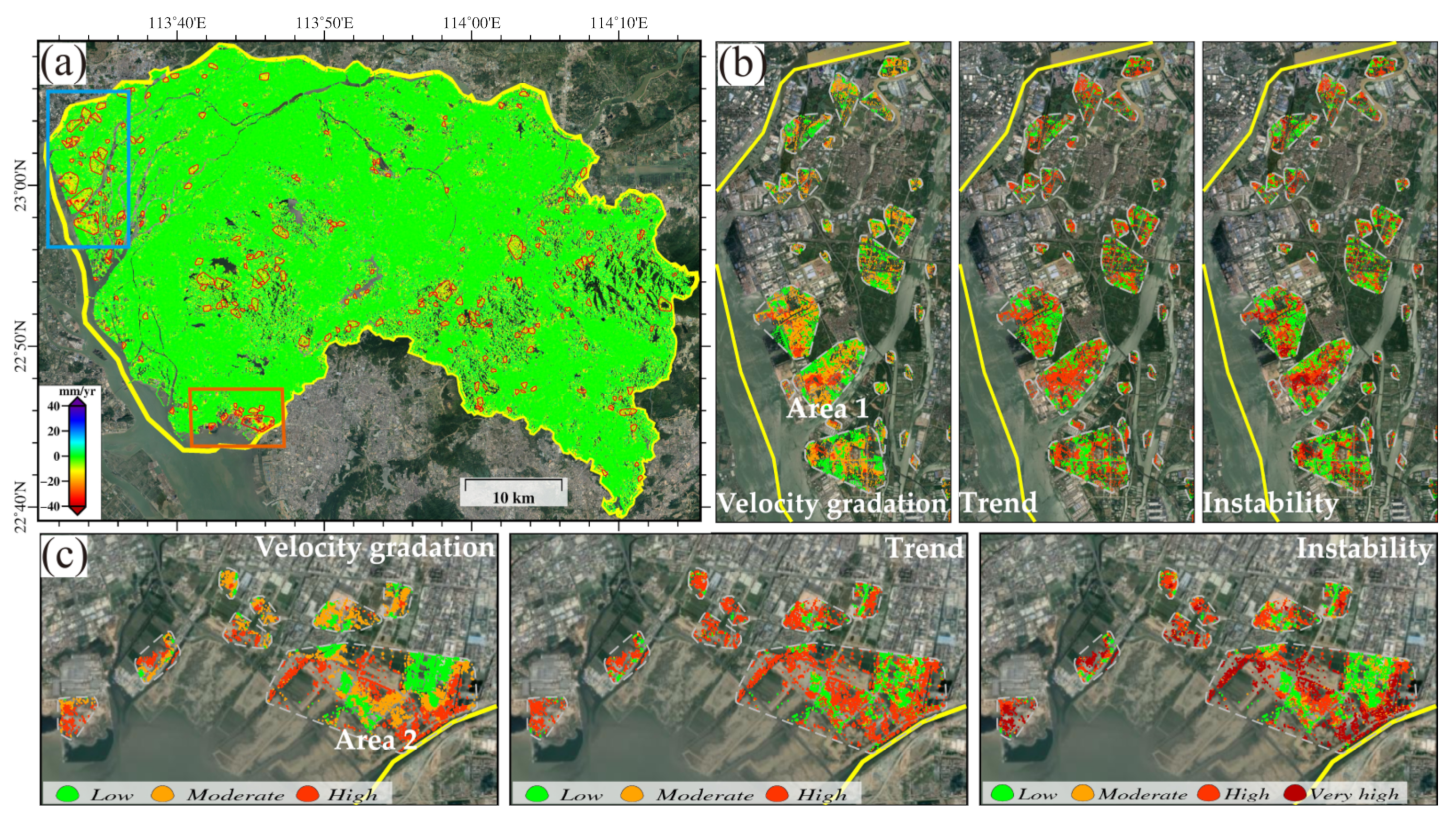
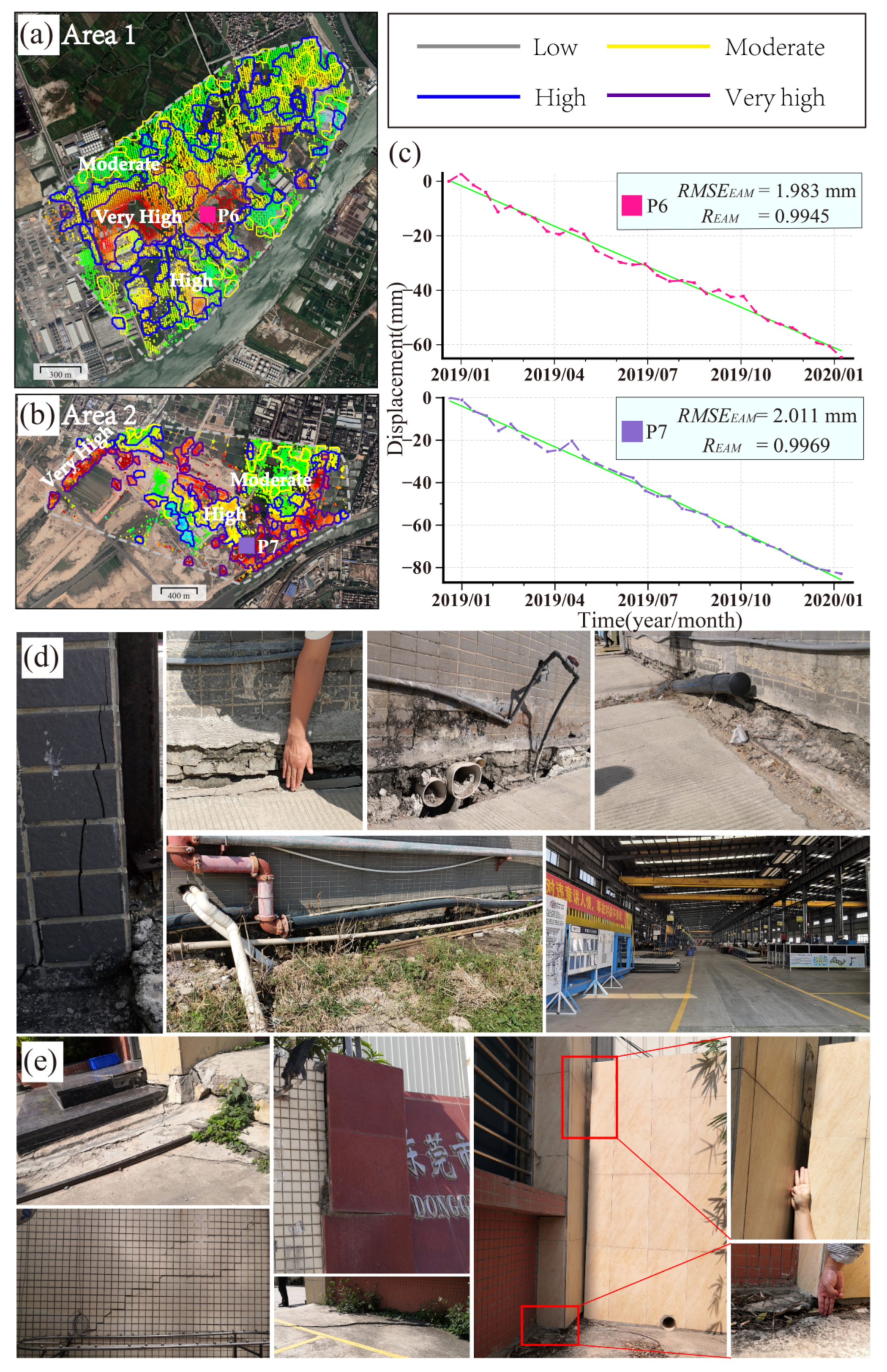
| Gradation | Threshold (mm/yr) |
|---|---|
| Stable point (low) | < 3σ |
| Active point (moderate) | 3σ < < 6σ |
| Highly-active point (high) | > 6σ |
| Study Areas | Direction | Orbit | Heading | Incidence | Pixel Spacing (Rg × Az) | Number of Images |
|---|---|---|---|---|---|---|
| Lajia Town, Qinghai Province (mountainous area) | Descending | T33 | −169.73° | 33.69° | 2.33 × 13.96 m | 71 |
| Ascending | T26 | −10.05° | 33.81° | 2.33 × 13.98 m | 73 | |
| Dongguan, Guangdong Province (urban area) | Ascending | T11 | −10.55° | 34.04° | 2.33 × 14 m | 32 |
| Index | Level | Low | Moderate | High | Very High | |
|---|---|---|---|---|---|---|
| Velocity gradation | Number of points | 3049 | 13,093 | 10,863 | ||
| Proportion (%) | 11.3 | 48.5 | 40.3 | |||
| Trend | Number of points | 1379 | 554 | 25,072 | ||
| Proportion (%) | 5.1 | 2.1 | 92.9 | |||
| Instability | Number of points | 1192 | 3274 | 12,111 | 10,428 | |
| Proportion (%) | 4.4 | 12.1 | 44.9 | 38.7 | ||
| Index | Level | Low | Moderate | High | Very High | |
|---|---|---|---|---|---|---|
| Velocity gradation | Number of points | 47,837 | 76,816 | 8957 | ||
| Proportion (%) | 35.9 | 57.6 | 6.7 | |||
| Trend | Number of points | 47,401 | 8932 | 77,277 | ||
| Proportion (%) | 35.5 | 6.7 | 57.9 | |||
| Instability | Number of points | 50,849 | 19,261 | 54,975 | 8525 | |
| Proportion (%) | 38.1 | 14.4 | 41.2 | 6.4 | ||
Publisher’s Note: MDPI stays neutral with regard to jurisdictional claims in published maps and institutional affiliations. |
© 2021 by the authors. Licensee MDPI, Basel, Switzerland. This article is an open access article distributed under the terms and conditions of the Creative Commons Attribution (CC BY) license (https://creativecommons.org/licenses/by/4.0/).
Share and Cite
Luo, S.; Feng, G.; Xiong, Z.; Wang, H.; Zhao, Y.; Li, K.; Deng, K.; Wang, Y. An Improved Method for Automatic Identification and Assessment of Potential Geohazards Based on MT-InSAR Measurements. Remote Sens. 2021, 13, 3490. https://doi.org/10.3390/rs13173490
Luo S, Feng G, Xiong Z, Wang H, Zhao Y, Li K, Deng K, Wang Y. An Improved Method for Automatic Identification and Assessment of Potential Geohazards Based on MT-InSAR Measurements. Remote Sensing. 2021; 13(17):3490. https://doi.org/10.3390/rs13173490
Chicago/Turabian StyleLuo, Shuran, Guangcai Feng, Zhiqiang Xiong, Haiyan Wang, Yinggang Zhao, Kaifeng Li, Kailiang Deng, and Yuexin Wang. 2021. "An Improved Method for Automatic Identification and Assessment of Potential Geohazards Based on MT-InSAR Measurements" Remote Sensing 13, no. 17: 3490. https://doi.org/10.3390/rs13173490
APA StyleLuo, S., Feng, G., Xiong, Z., Wang, H., Zhao, Y., Li, K., Deng, K., & Wang, Y. (2021). An Improved Method for Automatic Identification and Assessment of Potential Geohazards Based on MT-InSAR Measurements. Remote Sensing, 13(17), 3490. https://doi.org/10.3390/rs13173490







